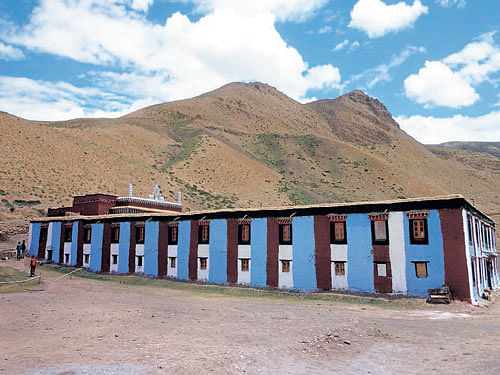
We had spent close to a week travelling around Shimla and exploring a few untread villages that borders our neighbouring countries.
After visiting towns Sarahan, Sangla, Chitkul, Nako, Gue and Dhankar, we arrived at Kaza, the administrative headquarters of the Spiti region. We gave an evening’s rest to the spine and decided to visit the twin high-altitude villages, Langza and Komic, the next day.
High-altitude splendour
In no mood to trek after a week-long hitchhiking, we rented a private car. The road from Kaza meanders along the Spiti river and then takes one up a dusty mountain, leading to the twin villages. A few foreigners were brave enough to cover the distance between Kaza and Komic, not much, 30-odd km, but for falling boulders, dust and sparse oxygen along the way.
We then viewed the Shila Valley, which has gorgeous yet treacherous snow-capped peaks — the Chocho Khang Namo (Black Mountain Princess, 5,964 m) and the Chocho Khang Nilda (Sun-facing Mountain Princess, 6,380 m, the third highest peak in Spiti).
The blue skies and the arid mountains dotted with greenery greeted us into the village of Langza. A huge statue of Buddha atop a knoll, also called Medicine Buddha, overlooked the valley and is believed to ward off any evil. The 600-year-old monastery, a branch of the Tabo Monastery, bore an unassuming look.
Later, a few kids and women tried to sell old fossils that they claimed were from the river bed. Though one could trek to the fossil base, which is around an hour’s walk from the Langza village, we preferred to let them remain in their open-air museum. Later, at Kaza, we found similar fossils being sold to tourists.
Land of legends
We continued towards the end of the road where Komic stood. Situated at an altitude of 4,587 m, it holds in its location a few more villages and an ancient ‘highest motorable’ monastery, Komic Lundup Tsemo Gompa or Komic Lundup Chhemo.
It belongs to the Sakyapa sect of Tibetan Buddhism and is expected to be at least 500 years old. A board forbade women from entering the monastery while a stuffed snow leopard greeted us in. ‘Ko’ refers to ‘snow cock’, ‘mic’ means ‘eye’, a name derived from one of the many legends associated with the land.
It was foretold in Tibet that a monastery had to be built with a mountain backdrop, to create the shape of a snow leopard on the left, a beheaded eagle on the right, and with four springs in its vicinity. The area in between the mountain had to take the shape of a snow cock’s eye, which marked the base of the monastery.
Yet another legend said that the 3-feet-tall statue of deity Mahakal became so heavy when robbers tried to steal it that they had to abandon it. It was then brought back to the gompa, its current den.
The mightiness of this staute is talked about in yet another legend — the Mahakal statue, believed to symbolise Dharma, did not budge from its foundation at Komic when the monks decided to shift it to the nearby, low-lying village of Hikkim. One monk stayed back and continued his prayers. An earthquake that hit the region in the 70s reduced Hikkim to rubbles, except for the Mahakal statue, which stayed unscathed. The monks who had left the village returned, and deemed the place holy.
A poetic recall
We were there only for a few hours, but a karmic connection reminded us the words of English writer William Hazlitt in On Going a Journey: “Give me the clear blue sky over my head, and the green turf beneath my feet, a winding road before me, and a three hours’ march to dinner — and then to thinking! It is hard if I cannot start some game on these lone heaths.
I laugh, I run, I leap, I sing for joy... I begin to feel, think, and be myself again. Instead of an awkward silence, broken by attempts at wit or dull common-places, mine is that undisturbed silence of the heart which alone is perfect eloquence.”
While leaving the monastery, a lama informed us about a few uncanny treasures — the tail of a man, horn of a unicorn, dragon’s egg, ribcage of what would be a big demon — which he called the land’s well-kept secrets.